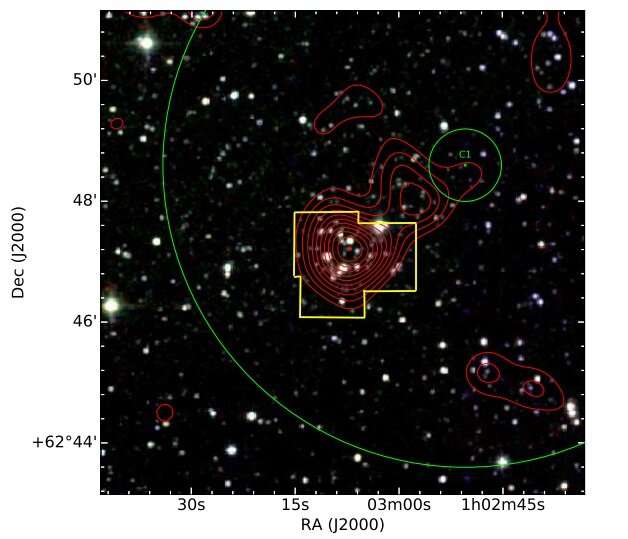August 18, 2020 report
Indian astronomers investigate open cluster Czernik 3

A team of astronomers from India has performed deep near-infrared photometric observations of an open cluster known as Czernik 3. The study provides important information about the properties of Czernik 3, suggesting that it is a disintegrating old open cluster. The research is available in a paper published August 7 on arXiv.org.
Open clusters, formed from the same giant molecular cloud, are groups of stars loosely gravitationally bound to each other. So far, more than 1,000 of them have been discovered in the Milky Way, and scientists are still looking for more, hoping to find a variety of these stellar groupings. Expanding the list of known galactic open clusters and studying them in detail could be crucial for improving our understanding of the formation and evolution of our galaxy.
Czernik 3 (Cz3 for short) is one of the poorly studied open clusters in the Milky Way. Its distance and age is still not well constrained. Initial observations suggested that it is located some 4,500-5,200 light-years away, and has an age of between 100 and 630 million years. However, other study points to an even larger distance of 5,700 light-years.
In order to resolve these discrepancies and to get more insights into the properties of Czernik 3, a group of astronomers led by Saurabh Sharma of the Aryabhatta Research Institute of Observational Sciences (ARIES) in India has performed photometric monitoring of this cluster. For this purpose, they employed the 3.6-meter ARIES Devasthal Optical Telescope (DOT). The study was complemented by archival data from ESA's Gaia satellite, the Panoramic Survey Telescope and Rapid Response System (Pan-STARRS1) and from the 2MASS catalog.
"Since most of the information about this cluster is derived from the not-so-deep photometric surveys, we have revisited this cluster and performed a detailed analysis to understand its dynamical evolution by using our deep near-infrared (NIR) observations taken from the recently installed 3.6-meter telescope at Devasthal, Nainital, India, along with the recently available data from the Gaia data release 2 and Pan-STARRS1," the researchers wrote in the paper.
The observations show that Czernik 3 exhibits an elongated morphology with fractal distribution of stars. The cluster's circular radius was measured at about 3.9 light-years, while its core radius was estimated to be around 1.63 light-years. The team managed to identify 45 stars as highly probable cluster members.
Czernik 3 was found to be older and more distant than previously thought. According to the study, the cluster is about 900 million years old, and is located approximately 11,400 light-years away from the Earth.
Furthermore, the astronomers found that Czernik 3 has a relatively shallow mass function (MF) slope and showcases a signature of mass segregation. Moreover, the dynamical age of Czernik 3 was found to be much less than the cluster's age.
The collected data allowed the astronomers to conclude that Czernik 3 looks like the remains of a cluster which has already lost many of its member stars. According to the authors of the paper, Czernik 3 is a loosely bound old cluster that may be in the process of dissolution under the influence of external tidal interactions.
"From the observed, small size of this old (∼0.9 Gyr) cluster as compare to its tidal radius, shallow MF slope, signature of mass-segregation, low density/large separation of stars, elongated and distorted morphology, dynamical relaxation time (TE=10 Myr) compared to the age of Cz3 (age=0.9 Gyr), we conclude that the Cz3 is a loosely bound, old disintegrating cluster under the influence of external tidal interactions," the researchers explained.
More information: Sharma et al., The disintegrating old open cluster Czernik 3, arXiv:2008.04102 [astro-ph.GA] arxiv.org/abs/2008.04102
© 2020 Science X Network


















